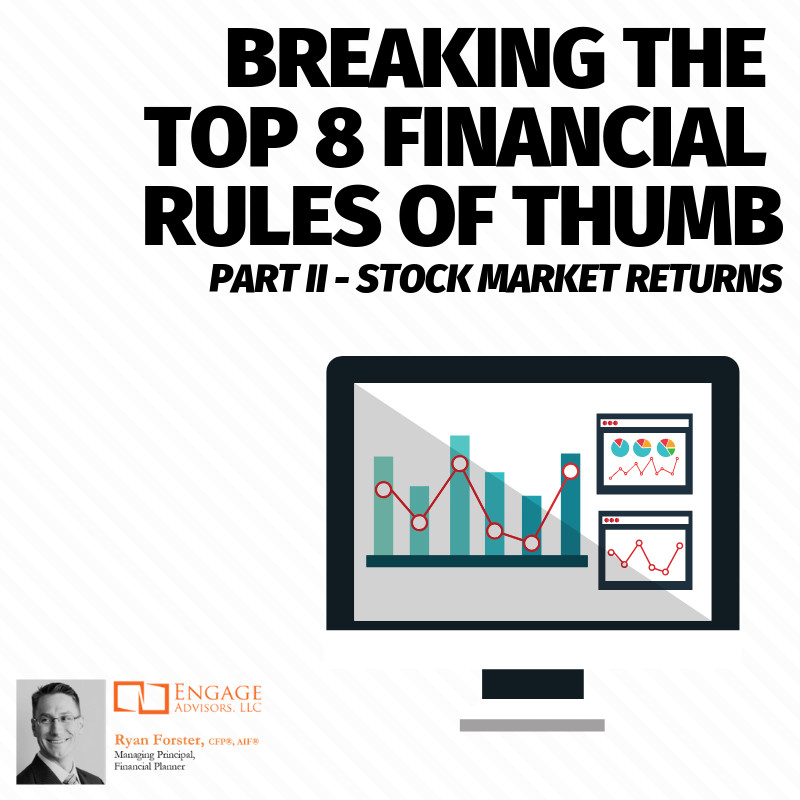“Don’t lower your expectations to meet your performance. Raise your level of performance to meet your expectations. Expect the best of yourself, and then do what is necessary to make it a reality.” – Ralph Marston
Broken Rule of Thumb: The stock market returns 10% per year. This simple assumption is why you’ll always find that one guy at the party arguing that it’s better to throw it all into an index fund. If there was an index that consistently pulled off 10%, there would be no reason for any other investment options. Reality is quite the contrary. Take the S&P 500, typically the most referenced index. It is very volatile and very inconsistent, and depending on the decade you pick, returns are widely divergent.
I’m not telling you index funds are bad. They aren’t and we use them! Both active and passive strategies can create a better risk/reward profile over time. In some years passive is better, in other years active is better. There’s no clear winner when proper due diligence is performed.
Index-only investing is inconsistent. Let’s take a look: the S&P 500 index took on its present form in 1957. Since then, it has returned right around 10% per year (if including dividends). This sounds compelling if you don’t look deeper. Annual returns by decade: 1960’s: +8% average, 1970s: +6% average, 1980s: +17% average, 1990s: +18% average, 2000s: -1% average. Historically the S&P 500 has been all over the board which is very hard to plan around.
Volatility can be emotionally painful. This is where do-it-yourselfers often fail. Can you truly put aside emotions when things get ugly? Case and point, take the last recession. The market fell by -57% from October 9, 2007, until March 9, 2009. What if you were retiring in early 2009 and you had saved $5 million in an index fund by October 2007, just 18 months until retirement? That would have dropped to a mere $2.15 million by ’09! It would be impossible to ignore the thought of losing everything. Many people sold at this point. This gut instinct is as responsible for wrecking retirements as the terrifying market was.
Volatility is expensive! The S&P 500 is very volatile. Take two investments of $100,000, both with an average return of 8% over a decade. Investment (1) grows at +8% every year without fail. Investment (2) is volatile but still earns an 8% average return with this sequence of returns: (years 1-10 respectively): +20%, +20%, -20%, +20%, +20%, -20%, +20%, +20%, -20%, +20%. Investment (1) earns +116% in the decade growing to $216,000. Investment (2) earns +83% because of the volatility growing to $183,000. This is the cost of volatility.
Volatility forces money to work harder. Why did investment (2) above do so much worse? Deep losses require investments to grow much more the deeper the loss just to break even. Here are the numbers. A loss of 20% needs a 25% gain to break even. A loss of 40% needs a 67% gain to break even. A loss of 50% needs a gain of 100% to break even. Even further, an 80% loss needs a gain of 500% just to break even. See the pattern?
The moral of the story: Win by not losing. Reducing volatility can increase your overall return on investment. We do this through diversification and asset allocation. Reducing the downside risk of a single stock, sector, index, or region can improve performance over a similarly returning, more volatile asset. Besides the shock of negative returns, the numbers alone suggest we shouldn’t just take on the riskiest asset with the unlikely hope of it having the highest performance. It’s important to be prudent when increasing your risk. There is a point where risk greatly outstrips reward.
If you would like to learn more about the sequence of returns, volatility, or any of the other topics in this blog, please call Ryan Forster at (913)681-9155 or email ryan@engageadvisors.com.
Engage Advisors, LLC is a Registered Investment Adviser. This platform is solely for informational purposes. Advisory services are only offered to clients or prospective clients where Engage Advisors , and its representatives are properly licensed or exempt from licensure. Past performance is no guarantee of future returns. Investing involves risk and possible loss of principal capital. No advice may be rendered by Engage Advisors, LLC unless a client service agreement is in place.

